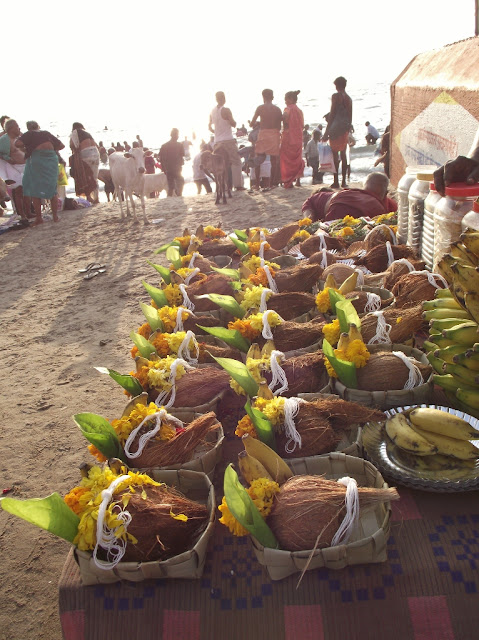The capitol of the Nilgiris district of the southern-most Indian state of Tamil Nadu is Udhagamandalam, or Ooty for those who can't pronounce the full name. Nilgiris means "blue mountains" in Tamil. Indeed, the Nilgiris are a bluish hue - outside of the protected forest areas much of the natural vegetation has been cleared for eucalyptus stands and tea plantations, reflecting green-ish blue light across the hillsides.
Ooty is home to a number of NGOs and government offices dealing with conservation issues in the Nilgiris. We sought out a few for interviews. A Mudumali national park
wildlife officer told us that the three greatest threats to the park were poaching, invasive species, and forest fire. In previous years poaching was a huge problem, but recent government
-run programs to employ villagers as anti-poaching watchers have brought improvements. Lantana, a bushy shrub, and parthenium, a toxic plant in the aster family, are the region's two worst invasive species, affecting food webs, agriculture, and human and animal health. Lantana, along with recent erratic rainfall, has made the park more susceptible to forest fires. The wildlife officer shared stories of his efforts to increase the park's fire management capacity, as well as to start programs to provide sustainable vocational training for local adivasi youth. He also revealed that, as is the case with many of India's national parks and protected areas, there are currently about 300 families living inside the park. India's conservation protocols
require that these people be relocated (for more on this controversial issue see the post on the Biligiri Rangaswamy Temple Wildlife Sanctuary). In a deal many are calling the "golden handshake", the government has offered families living in the park 10 lakh rupees (1 million rupees or about 21 thousand dollars) as well as land outside the reserve as incentive to leave. By all accounts this is a great deal. However for many families, the emotional and historic significance of their ancestral home in the park outweighs the financial benefits of moving.
Making our way to Ooty's sister town of Kotagiri, we met with the director of the Keystone Foundation, a natural resource and rural development NGO that has been working in the Nilgiris since 1995. The Keystone Foundation emphasizes the need to include local people in natural resource management decision-making. Its work includes reviving natural vegetation, environmental governance, documenting indigenous knowledge of biodiversity and local cultural practices, and promoting the sustainable harvest of non-timber forest products such as honey, beeswax and fruit. The Keystone Foundation also works to implement the 2006 Forest Rights Act, a piece of legislation restoring rights of forest use back to traditional forest dwellers and indigenous people. This legislation, enacted by the Ministry of Tribal Affairs, is seen as a threat by the Forest Department, an entrenched bureaucracy with a history of managing forest land for timber revenue rather than wildlife or the livelihoods of local people. The story of the Forest Rights Act and the Forest Department is a fascinating one that I will discuss in a subsequent post.
Tea cultivation plays an important role in the economy and ecology of the Nilgiris. The state government, under pressure to increase local incomes and standards of living, provides subsidies of 60,000 rupees per acre for tea cultivation and has ambitious plans to expand production. However the Keystone Foundation maintains that this incentive system leads to superficial land values and no recognition of the significance of the greater landscape. A lack of rules promoting soil and water conservation results in loss of trees and soil through erosion. The money spent on tea subsidies would be better spent encouraging the cultivation of local millets that have less environmental impact and increased food sustainability benefits. But tea cultivation provides reliable income for 10 months of the year, and it is much more difficult to quantify the benefits of preserving traditional crops and intact ecosystems.
Deciding our understanding of the Nilgiri biosphere reserve was incomplete without seeing tea production up close, we talked our way into an impromptu tour of one of Kotagiri's big plantations. The tea warehouse was a massive dimly lit space, filled with giant steel machines and the fragrant aroma of Nilgiri tea. Sunlight from the skylights filtered down through motes of tea dust permeating the air. A fine film of tea layered every surface and clogged every knook and cranny of the machines.
Tea leaves are plucked by hand and carried into the processing warehouse, where they are left to wither for a number of hours under fans. This tea factory used the CTC method (crush, tear and curl) to process their product. After being bruised and fermented, the tea leaves are then passed through a machine with cylindrical rollers with sharp teeth that, yup, you guessed it, crush, tear, and curl the leaves. Over 80% of tea production in India is of this sort and is suitable for use in teabags or for the loose tea used in making the ubiquitous Indian chai. CTC tea produced in the Nilgiris has mild tannin, a generic flavor, and is low cost, contributing to its popularity in the Indian domestic market.
 From the town of
From the town of 










